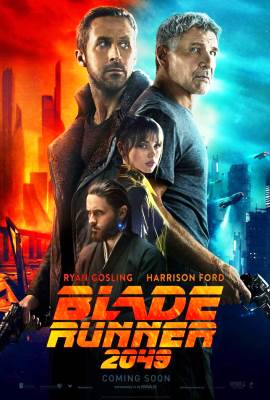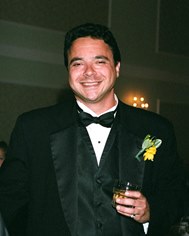 Director Denis Villeneuve’s “Blade Runner 2049” completely envelops you and makes for an engrossing sequel to Ridley Scott’s 35 year-old futuristic film noir.
Director Denis Villeneuve’s “Blade Runner 2049” completely envelops you and makes for an engrossing sequel to Ridley Scott’s 35 year-old futuristic film noir.
The minutes flew by for me as I got absolutely absorbed with “2049,” something that surprised me because a) “2049’s” almost 3 hours long and b) while I liked 1982’s “Blade Runner,” I wasn’t a rabid fan. Having read the short story upon which “Blade Runner” was based (Philip K. Dick’s “Do Androids Dream of Electric Sheep?”), I found Scott’s film more a visual feast than a meticulously-crafted mystery. However, my interest in “2049” really belongs to writer Hampton Fancher- having written the original “Blade’s” screenplay, he returns to give “2049’s” story more character catharsis than android anarchy.
“2049” takes place 30 years after the events of “Blade Runner,” so while your enjoyment is enhanced having seen Scott’s film, it’s not crucial: “2049” works well as a stand-alone movie. One basic fact you do need to know: even after three decades in Los Angeles, blade runners still hunt replicants (explained in opening titles for the uninformed, blade runners are policemen who kill renegade androids called replicants- in the future, humans created replicants to work as slave labor for an off-world colony; using their super strength against humans, replicants rebelled and were hunted). While Scott’s film took place in 2019 when Rick Deckard (Harrison Ford) was the L.A. blade runner assigned to hunt replicants before disobeying his duty and running off with Rachel, the replicant he fell in love with, Officer K (Ryan Gosling) is now the blade runner on Deckard’s beat.
While some things stay the same, some things change: Officer K is a replicant himself. Over time, replicants were improved with increased obedience, thus giving them a purpose on Earth versus just being employed off-world. While K’s job is to “retire” older-model replicants who lack the obedience design, he’s still a replicant hunting other replicants and that makes him a scourge on his city block. K’s only solace from being harangued for his hypocrisy is being in his apartment with Joi (Ana de Armas), K’s aptly-named cute companion who’s really just a computer-generated hologram. Joi is dutiful and her beauty is ethereal- literally ethereal because she’s an image created from a console on K’s apartment ceiling. Programmed by K, she knows and loves him, but has her love developed over time or been programmed as well? This question of emotions and souls among the synthetic are the seeds that begin to blossom for our new blade runner and what makes “2049” a sci-fi movie that satisfies.
It begins when a mystery develops on one of K’s cases involving…a case, buried for 30 years and containing a human skeleton. A coded tag on the pelvic bone soon tells us the skeleton is not human but replicant, yet the bones bear signs of childbirth. Can replicants conceive? And what’s with that date carved on the tree under which the case was unearthed that’s familiar to K? K’s investigation leads to more questions, both external and internal, gaining the interest of the new replicant-making guru Niander Wallace (Jared Leto) and his synthetic sidekick Luv (Sylvia Hoeks) until all roads eventually lead to one man for the missing piece of the puzzle, you guessed it- that deserting-blade runner Deckard (Ford, reprising his role).
Great sequences directed by Villaneuve (“Arrival, “Sicario”) and singular cinematography by Roger Deakins (after 13 Oscar nods, can’t this guy finally win for this movie?) only added to my enjoyment of “2049.” With “2049’s” strong emphasis on questioning artificial life’s ability to feel (in layman’s terms, is it real if it feels?), it takes “Blade Runner’s” last replicant standing Roy Batty (Rutger Hauer) trying to buy himself more time to be alive to a new level with Gosling’s portrayal of Officer K in this film, doubting his memories as implanted or real and playing to this inner conflict- I’m sure it’s why Gosling jumped at the chance to be in the film (memorable sci-fi movie sequel aside). In fact, all of the actors work well in their roles- even Ford, who has a great scene shakily confronting his past with Leto.
Apart from its deeper questions, “2049” works as an entertainment because it’s not controlled by its effects, it’s enhanced by them. From K’s car being outfitted with a sunroof that becomes a surveillance drone to Joi hiring an escort for her hologram to merge with and consummate her relationship with K to Wallace’s sight-impairment being repaired with the aid of a gadget fixed to his skin that controls small flying robotic drones that act as his “eyes,” the effects dazzle without distracting.
One of this year’s best, it’s also one of the best sci-fi movies I’ve seen. “2049” answers its own question as it ponders what it means to be alive- it provides us with a richly entertaining journey.
